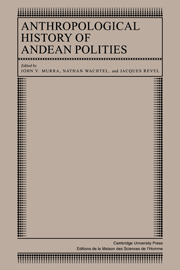Book contents
Part III - Systems of classification
Published online by Cambridge University Press: 05 October 2010
Summary
Soon after the European invasion, the newcomers became familiar with a few score indigenous nouns. They discovered the khipu, a knot-string record used in bookkeeping and the enumeration of people; it came in handy when granting encomiendas, since both the Andean and peninsular law dealt with souls liable to tribute, not territory. They were delighted to find an existing servile population, the yana; this permitted the accumulation of “perpetual servants” without contravening royal ordinances prohibiting the enslavement of “Indians.” They had some trouble understanding what tupu stood for, since it measured not only surfaces but also distances; it differed too, according to the ecological fit of a given plot of land. They had no trouble adopting the mifa, which facilitated the mobilization of thousands of workers far from their homes.
And yet despite (or maybe just because of) the ready adoption of these terms into the colonial vocabulary, the Andean implications, the shades of meaning, frequently even the most elementary glosses of these concepts escape us.
Whether we are thinking of access to land or about royal lineages, of the state's revenues or the drafted hosts, it is indispensable to understand the fundamental concepts underlying the organization of Andean societies from inside the system. But we face this task four centuries too late. Although Andean languages are still spoken by about 10 million people, much of the esoteric vocabulary dealing with statecraft is lost. The kind of sophisticated consultant available to Eric de Dampierre, Jan Vansina, or Ivor Wilks in Africa has long since vanished in the Andes.
- Type
- Chapter
- Information
- Anthropological History of Andean Polities , pp. 119 - 120Publisher: Cambridge University PressPrint publication year: 1986



